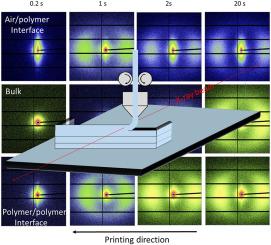Development of polar phases in poly(vinylidene fluoride-co-hexafluoropropylene)/Expanded Graphite composites during 3-D printing as revealed by “operando” small and wide angle X-ray scattering
IF 4.5
2区 化学
Q2 POLYMER SCIENCE
引用次数: 0
Abstract
Here we present a research work about the crystallization of poly(vinylidene fluoride-co-hexafluoropropylene) (PVDF-HFP) and of one PVDF-HFP composite with expanded graphite (EG) as nanoadditive during 3D printing Fused Filament Fabrication (FFF). Simultaneous Small and Wide Angle X-ray Scattering experiments (SAXS and WAXS) were performed “in situ” under “operando” conditions. The X-ray experiments clearly reveal the presence of a polar phase in the PVDF-HFP/EG while for PVDF-HFP its presence is not obvious. Complementary Fourier Transform Infrared Spectroscopy experiments corroborate the presence of the polar phase for both materials. For PVDF-HFP crystallization is faster at the interfaces (polymer-air and polymer-polymer) than in other points within a printed line, being the crystallinity lower at the interfaces. However, for the PVDF-HF composite, neither crystallization rate nor crystallinity is dependent on position. The effect of EG, acting as nucleating agent, has been discussed as being the reason for this behavior.

“operando”小广角x射线散射揭示了聚偏氟乙烯-共六氟丙烯/膨胀石墨复合材料在3d打印过程中极性相的发展
本文研究了聚偏氟乙烯-共六氟丙烯(PVDF-HFP)和一种以膨胀石墨(EG)为纳米添加剂的PVDF-HFP复合材料在3D打印熔丝制造(FFF)中的结晶过程。同时在“operando”条件下进行了小角和广角x射线散射实验(SAXS和WAXS)。x射线实验清楚地显示PVDF-HFP/EG中存在极性相,而PVDF-HFP中极性相的存在并不明显。互补傅里叶变换红外光谱实验证实了两种材料的极性相的存在。PVDF-HFP的结晶在界面处(聚合物-空气和聚合物-聚合物)比在印刷线内的其他点要快,因为界面处的结晶度较低。然而,对于PVDF-HF复合材料,结晶速率和结晶度都不依赖于位置。讨论了EG作为成核剂的作用是造成这种行为的原因。
本文章由计算机程序翻译,如有差异,请以英文原文为准。
求助全文
约1分钟内获得全文
求助全文
来源期刊

Polymer
化学-高分子科学
CiteScore
7.90
自引率
8.70%
发文量
959
审稿时长
32 days
期刊介绍:
Polymer is an interdisciplinary journal dedicated to publishing innovative and significant advances in Polymer Physics, Chemistry and Technology. We welcome submissions on polymer hybrids, nanocomposites, characterisation and self-assembly. Polymer also publishes work on the technological application of polymers in energy and optoelectronics.
The main scope is covered but not limited to the following core areas:
Polymer Materials
Nanocomposites and hybrid nanomaterials
Polymer blends, films, fibres, networks and porous materials
Physical Characterization
Characterisation, modelling and simulation* of molecular and materials properties in bulk, solution, and thin films
Polymer Engineering
Advanced multiscale processing methods
Polymer Synthesis, Modification and Self-assembly
Including designer polymer architectures, mechanisms and kinetics, and supramolecular polymerization
Technological Applications
Polymers for energy generation and storage
Polymer membranes for separation technology
Polymers for opto- and microelectronics.
 求助内容:
求助内容: 应助结果提醒方式:
应助结果提醒方式:


